I will confess upfront, that I got roped in a bit on this one. Megumi perhaps inspired by Nepal was dead keen to do it before the glaciers disappeared! I was happy to go along and help her achieve it, although I was not all that inspired and for these reasons probably didn’t research or really take the whole thing seriously enough, but anyway…
For those that don’t know, Mt Kilimanjaro is on the border of Kenya / Tanzania and at 5,895m it is the tallest mountain in Africa and indeed taller than all the mountains in Europe and many other continents besides. The mountain is particularly stunning and its snow capped, glacier covered cone rises from the surrounding plains to dominate the African landscape, somewhat similar too if not more imposing than Mt Fuji in Japan. While we had passed “Kili” several times in our travels so far, we had yet to really see it. The mountain seemingly constantly enveloped in cloud. It’s a strange thing, climbing something you have never seen.
Climbing Kili is not cheap though no matter how you go about it. It costs at least $1,000 per person to do. Half of this is due to the national park fees, something like $100 per day, the rest covers the compulsory guides and porters necessary to transport all your food, cooking gear (you need to bring your own gas) and other supplies including a tent (if you are camping). Megumi had found a company Zara, that offered a pretty reliable package according to other Japanese bloggers she had read, all had had a great experience with them. So we signed up, rocked up to Moshi from Nairobi and set about preparing to climb.
Now anyone that has seen our facebook updates already knows how this story ends, so I will get a few excuses in early here. While climbing Kili is one off those big touristy things to do in Africa (about 12,000 people try it a year), it is also a pretty intense challenge. Altitude sickness (AMS) is a serious problem for everyone who attempts it and Kili kills (twice as many people as Everest apparently), it had already accounted for a young 30 year old guy as recently as 3 weeks ago. I had actually come down with a bit of a cold in Nairobi, but it was only a light sinus infection and thinking that in Nepal I had had no real trouble with AMS, (whereas Megumi had really struggled) I didn’t particularly take it seriously. I just bought a bagful of chems to stave things off, if it got any worse.
On arriving at Zara, we received a short briefing on the climb and along with the other member of our climbing posse, a Canadian woman named Joanne, got introduced to our guide (Felix) and his cousin and assistant guide (Wilson) for the trek. From conversations with other returning climbers we knew it was going to be very cold (and wet) so introductions done, we set about hiring essential gear – sleeping bags, rain gear, walking sticks and other such stuff and packed our bags. Simple really!
Next morning, we set off at about 9am. We had chosen to do the easy climb, the Marangu route which features convenient huts at the key stops along the way. We were attempting to do the climb in 5 days, without an acclimatization day, which is pretty aggressive but not that uncommon and didn’t seem to affect success rates either way. These days most people try to climb via the Machame route which is a little more scenic, takes 6 days so offers better acclimatization, though with no huts it requires tents and the additional ensemble of supporting porters and gear. With lots of rain about, this camping option hadn’t really appealed to us much. Even though we were staying in huts though, we still required 3 porters for my and Megumi’s gear and food, plus a cook, a waiter and the 2 guides all shared across the party. In total for ourselves and Joanne, it represented a support team of 9 people. In Nepal, we had had just one!
Arriving at the gate of the park before noon, we set about climbing. Day One was an easy, 3 hour gradual, gravel road climb through a scenic rainforest. Not particularly exerting it was quite enjoyable. We ambled along deeply in conversation with Joanne, trading backgrounds and stories; the tree’s all covered in moss and lichen, monkeys making noise in the tree-tops, all pretty pleasant stuff. When we stopped briefly for lunch, 2 Mongoose kept darting out from the bushes, rather sinisterly hunting for scraps. Arriving mid afternoon at the first set of huts and our stop for the first night, we found a family of black and white Colobus monkeys and 20 odd schoolkids on an excursion. After checking into our nice 4 bed hut, we had some afternoon tea & popcorn and then did a brief acclimatization walk up to a nearby crater. The thinking being walk higher and sleep lower to better help you adjust to the altitude. We were now at 2,800 metres – not much higher than Nairobi where we had been staying for the last 2 weeks, so everyone was feeling pretty good.
The next day, we set off about 9am with our guides; the porters and cooks had already taken off earlier up the trail, bags, cooking gear and baskets of food perched precariously atop their heads, African style. The second days climb was about 5-6 hours, rising about 1,000m – again nothing too steep or challenging, just a slow gradual climb into altitude. An hour into the walk, the tree’s started to drop away and the landscape transition into heather, moor and a fascinating local tree species that only grows above 3,000m not dissimilar to Australian “grass trees”. As we rose further, we started to ascend through the cloud layer experiencing a little rain and while we glimpsed some heavily veiled peaks in the distance, Kilimanjaro remained cloaked throughout.
The Horombo camp, was a pretty collection of huts, located on a river above a helipad, the view backward and beyond was that of an endless sea of clouds, quite stunning. At 3,700 m, we were starting to get into AMS territory, although all 3 of us were feeling fine. Again arriving mid-afternoon, we enjoyed our tea and popcorn (our last actually – it was giving us all gas!) and climbed up a few hundred metres in the late afternoon, just to gain some acclimatization before returning back to bed. After a solid meal, we slept soundly in our little hut, although the cold was starting to kick in more seriously now.
The next day was much like the 2nd only colder and we broke out the jackets and wet weather gear for another 6 hour gradual climb up a further 1,000m. Here the path climbed out of the heather and the ‘grass trees’ into an arid, alpine desert landscape inching closer to the craggy peaks. Winds howled across the empty, stoned landscapes adding a decided chill to events. Largely uneventful, we started passing a few other climbers coming down most looked exhausted, a few elated. As we got close to the Kibo Hut, our end destination for the afternoon, the path steepened and in the high altitude we experienced our first real climbing test. Nothing too challenging, but it left us short of breath, we could suddenly feel how high we were.
Arriving at Kibo Hut at around 4700m, we met several other climbers just recently descended, all were quite exhausted and they left little doubt at how hard the task was going to be from here. We got billeted into our dorm, a large room with 20 bunks and a table in a large cold hut; we promptly dumped our bags and crashed out. Now at this point, I had barely raised a sweat and was feeling really good, despite the dripping tap for a nose. However, when we awoke after a short nap, things were a little different. Joanne was feeling terrible, so we walked up the slope a few hundred metres to see if some that would help. Along the way she was overcome with nausea and threw up – not good signs. Not feeling that great either I postulated that maybe the sleep was the problem, the light breathing of sleep bringing on AMS as the body was starved of oxygen. Back at the hut, we had dinner around 5pm, Joanne and I had little appetite, though Megumi threw down enough pasta for both of us. As we did so, we watched another young male climber out our window throw up into the hillside, apparently everyone does it up here, says our guide, nothing to worry about.
The plan was to sleep until 11pm, get up, dress in everything we had and set off for the climb about 11.30pm. I promptly fell into a deep sleep and next thing I knew was being woken up. Suddenly though, I felt terrible – just getting dressed was an impossible effort and brought on waves of nausea. Jo-anne hadn’t slept much at all and though not great was feeling ok, Megumi was raring to go. The sleep thing had obviously affected my badly – I hate it when I am right. Grabbing a handful of cold and flu tablets, some panadol and diamox (for altitude) I struggled out the door. I knew I was in a lot of trouble.
The first hour of the climb or so, was a slow trudge uphill under a stunning starry sky. No-one was saying much and I tried to battle through the nausea and tiredness thinking I could just work it off. Suddenly though, I experienced a dizzy spell and almost fainted, throwing out a pole to catch me for support. Our guide, Felix was in front and his assistant guide (and cousin, Wilson) was behind me bringing up the rear. They kept up a steady conversation in Swahili throughout and I knew I was under close observation. After the first dizzy spill, things got worse, I struggled to breathe, my nose completely blocked, every move became a huge effort and I was unable to get enough air through my lungs. I was forced to stop several times, my heart thumping, desperately short of breath, on the verge of throwing up and dizzy. Each time, Felix pushed me to keep going, each time I did thinking I might improve and it got worse. After 2 or 3 attempts at this, I realized I was simply unable to keep it up, headaches were circulating ominously now as well. We were only 2 and 1/2 hours into the climb, just over 5,000m which meant we had 5 hours more of this (and another 800+ metres) still to go and we hadn’t even hit the steep bits yet. Megumi was full of beans at this stage and Joanne, while grateful to stop, seemed to be doing fine as well. Felix was talking with Wilson about perhaps splitting the teams, one moving slowly, me, and the other pushing on to reach the peak at sunrise. I decided to give it one more go, but only lasted a couple of minutes before coming to an exhausted, breathless stop amid another dizzy spell. A cold reality and truth settled in, I could not go on. Normally I ooze willpower and there are very few times in my life that I have not achieved anything I set my mind to. But I realized this was just becoming physically impossible, mind would not bend matter. My breathing apparatus may have only been down 10-15% because of my flu, but I simply couldn’t get enough oxygen at this altitude and the resulting nausea, weakness and dizziness was pushing me to unsafe limits with AMS. I decided to turn back.
After checking my pulse and heart, Felix decided to take me back down, as guide he was totally responsible and if my situation did not improve or got worse back at camp, he would have to take me down further or organize to sled / chopper me out. Wilson the assistant guide would push on with Megumi & Joanne. Megumi, god bless her, was happy to come back with me as well, but I urged her on telling her I would be fine – this was her dream after all! Immediately after we started down I began to feel better and knew I had made the right decision, I had been at the physical limit and my body simply could not support what would be needed of it over the next few hours. Back at camp, we could see the lights of the others high up on the side of the mountain and under Felix’s careful watch I collapsed, exhausted into my bunk – still suffering intense waves of nausea. It was just after 3am and I had no problems falling asleep, while I waited for the others to return.
As to the ascent, I can only narrate what Megumi and Joanne told me afterwards. Megumi apparently had little trouble at all (according to Joanne), though Joanne said she had herself really struggled. Apparently about an hour after I turned back they hit a really steep incline which left them both breathless and exhausted – they both agreed afterwards that I had made the best decision turning back when I did. In all they spent 6 hours ascending step by step, constantly short of breath in the high altitude, taking in large sweeping u-turns and a gruelling last hour up the sharp rocky incline to Gilmans Point; then traversing across the snow a further 2 hours to Uhuru, the highest peak, with clear commanding views above the clouds and of the glacier, arriving just after sunrise. They were on a high and at the roof of Africa, though suffering from too much altitude to really dwell on it much. Megumi was elated to see the glacier and realize it was still in such stunning condition. Though completely exhausted, somehow she still had enough energy left to take a stack of photo’s and document everything along the way. The trip down only took 3 or so hours, coming straight down the gravel inclines they had worked so hard to zig-zag up at night. Felix sent up our waiter Manuel, a real entertainer, to meet them and grab their day packs and ease their final hour or so of descent.
When they both walked into the hut a little later, they were clearly exhausted, though Megumi still seemed to be jumping around the room. Both claimed it was the hardest thing they had ever done and neither wished to ever do it again (but perhaps they were just being nice). Though still feeling nausea I was definitely significantly improved and though well short of an appetite, we forced a quick breakfast and rather than delay any further with rest, decided to keep going down the mountain back to the Horombo hut and lower altitude as soon as possible. While mostly downhill, it was still a long way (12 km) after the all night exhaustions especially of the others and we stumbled into camp mid afternoon with very little energy left. Everyone slept well that night!
The final day was basically walking back down the paths of day 1 and 2 combined. We left very early, all our legs really feeling it, but in the lower altitude we were in good spirits and able to make good time. We got back to the hotel sometime around 3pm and after sorting out tips for our large posse of helpers, settled back with a few civilizing beers, some wine, rewarding hot showers and clean clothes
And that was it, funny really. I was outdone by 2 girls. I had felt physically fine right up until the final ascent and then it was all over before I knew it. In the next few days, I wondered what I could have done differently. Strangely for once in my life, I don’t think the climb or the fitness was the problem. The simple truth was that I had underestimated what was required and should have waited to do the climb in better health. Under the microscope of high altitude I was simply found wanting. No shame in it really though, I have heard as many as 40% don’t actually make it to the top. And as solace, the local beer Kilimanjaro has a t-shirt that says, “if you can’t climb it, drink it.” I have seen people wearing it – all good advice, which I have been diligently following since. Now I just need to find out where to buy one.….
![Of Climbing Kilimanjaro I will confess upfront, that I got roped in a bit on this one. Megumi perhaps inspired by Nepal was dead keen to do it […]](http://meltingplots.com/wp-content/uploads/2010/05/Kili_top.jpg)
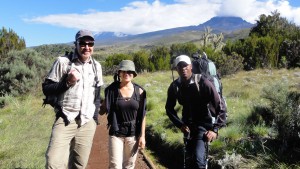
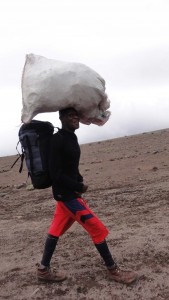
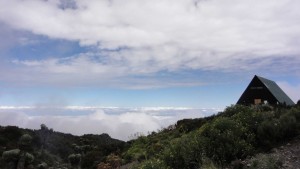
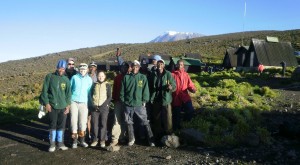

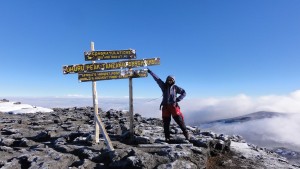
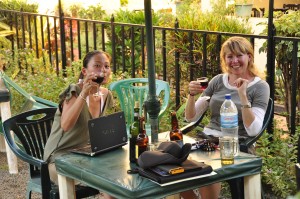
Thanks mate – appreciate all the support! Looks like we are following closely in your footsteps. Currently en route to Egypt then over landing through Jordan, Syria, Turkey et al to Iran! Sounds like you had a great experience – can’t wait to trade tales at some point!
hey fella – just as well you didn’t hang onto the ring in Nepal!
it takes more guts to turn around than keep going, you did good nev, real men know when to quit.
be good
Thanks – was lots of fun, despite finishing a little short. At least I had Megumi to carry the flag! Hope you guys are doing well!
Well done, guys, to have gone as far as you did. Otsukare…